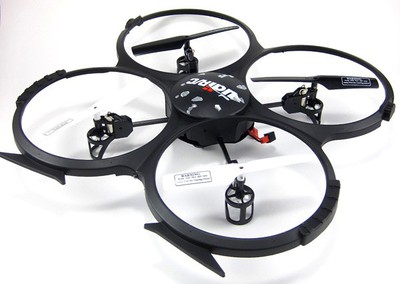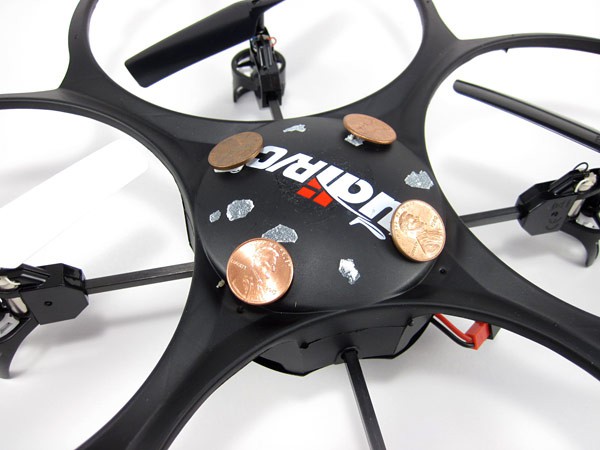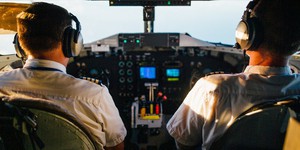Abstract
Drones—also called quadcopters or unmanned aerial vehicles (UAVs)—are an increasingly popular toy for hobbyists. Some companies even want to use them for business purposes, like delivering packages right to your doorstep! However, drones typically have a rather short battery life. Does the added weight of a package affect a drone's battery life? Try this project to find out!Summary

Objective
Measure whether added weight impacts the battery life of a drone.
Introduction
You might have heard the word drone a lot in the news lately. At first the term was mostly used to refer to military aircraft that are piloted remotely (meaning, there is no human pilot sitting on board the aircraft), but recently "drone" has also been used to refer to small remote-controlled toys piloted by hobbyists, like the one in Figure 1. These toy drones are also frequently called quadcopters since they have four spinning blades (see the Technical Note). Many drones have on-board cameras so they can be used for aerial photography and videography. Some companies, like Amazon and Google, even want to use them to deliver packages directly to people's doorsteps!

Figure 1. An example of a toy drone, commonly called a quadcopter, since it has four blades.
Package delivery introduces a big challenge, though. Many small drones have a short battery life, meaning the amount of time the drone can fly before the battery depletes and needs to be recharged. In order to stay in the air, a drone must generate lift, or an upward force (or push) that overcomes the downward force (or pull) of its weight due to gravity. This lift is generated by spinning propellers. The propellers are driven by electric motors, which draw electrical power from the batteries. Increasing a drone's weight means it has to generate more lift to stay in the air, meaning its propellers have to spin faster. Spinning those propellers takes a lot of energy, which can drain the battery quickly. For small toy drones, the battery life is usually less than 10 minutes. This limits how far the drones can fly, especially if they need to make a round trip to drop off a package and return.
In this project, you will add weight to your drone by taping coins to its frame. You will then measure how long the drone can fly before the battery dies, recharge the battery, and try again with a different number of coins. This will let you collect enough data to see how added weight affects the battery life. Are you ready to start your own drone package delivery business?
Technical Note
Mass vs. WeightAlthough in everyday language it would be common to answer "How much does the drone weigh?" with "The drone weighs 100 grams," technically this is incorrect. In the metric system (which is always used for science), grams are a unit of mass, not weight. Mass and weight are not the same thing. Weight depends on gravity, and in the metric system it is measured in newtons (N). You weigh more on Earth than you would on the moon, because the moon has less gravity than Earth. Mass, however, does not depend on gravity. Mass is a measure of how much matter (atoms) you are made up of. Gravity does not change that, so your mass is the same on Earth as it is on the moon.
When you add coins to your drone, you are increasing both its mass (you are adding more matter) and its weight (since gravity is pulling on that matter). However, since most kitchen scales provide measurements in grams, not newtons, you should make sure you refer to the "mass" of the drone—not the weight—when recording data for your project.
Definition of "drone"
As noted in the introduction, use of the word "drone" has changed over time. Hobbyists have been flying model aircraft—primarily small radio-controlled (RC) planes and helicopters—for decades, and they were not referred to as drones. For a long time, this was a fairly specialized hobby, as the aircraft were more expensive and more difficult to fly. The word "drone" in recreational context (as opposed to military) became common in the early 2010's mostly in reference to quadcopters (more generally called "multirotors," since some models have six or even eight blades), many of which contained on-board cameras. Technological advances made quadcopters increasingly cheaper and easier for beginners to fly, leading to their rise in popularity. Today they are flown for recreational and business purposes (for example, aerial photography during sporting events). More generally, any aircraft that does not have an on-board human pilot can also be referred to as an unmanned aerial vehicle (UAV) or unmanned aerial system (UAS). Some hobbyists object to the use of the word "drone" to describe these aircraft, due to the association with military technology, but Science Buddies will stick with the current popular usage.
Terms and Concepts
- Drone
- Quadcopter
- Battery life
- Lift
- Weight
- Gravity
- Motor
- Mass
Questions
- How do you think adding weight to a drone will affect its battery life?
- What are some real-world (non-recreational) uses for drones?
- What people and organizations use drones (for example, individuals, businesses, government)?
- What problems can be caused by drones if they are not used responsibly?
Bibliography
- Iyengar, R. (2015, November 2). Google Plans to Start Drone Delivery by 2017. Time. Retrieved December 22, 2015.
- Musil, S. (2015, November 29). Amazon delivery drones get a new look. CNET. Retrieved December 22, 2015.
- Wikipedia contributors. (2015, December 20). Unmanned aerial vehicle. Retrieved December 22, 2015.
- MITK12Videos. (2012, April 12). Indoor Flying Robots. Retrieved December 24, 2015.
For help creating graphs, try this website:
- National Center for Education Statistics, (n.d.). Create a Graph. Retrieved June 25, 2020.
Materials and Equipment
- Drone, also commonly called a "quadcopter." A variety of drones are available from
Amazon.com.
- Drones are available at a wide range of price points—from small, inexpensive toys that fit in the palm of your hand, to larger professional models that cost thousands of dollars. It can take some practice to learn to fly a drone well, so Science Buddies recommends using a cheaper model if you are just starting out. You do not want to get your brand-new thousand dollar drone stuck in a tree!
- Optional: One or more extra batteries for your drone. This will allow you to speed up the experiment by performing several trials before you need to recharge the batteries. We recommend doing at least 9 trials, total, and many drone batteries take over 1 hour to charge for less than 10 minutes of flight time. Take this into account when you plan your experiment.
- Large, open area that is free from obstructions, where you can safely fly your drone. The location should be easy to get to, since you will have to go back and forth multiple times to recharge your drone's batteries between flights. Here are some examples of recommended places to fly your drone for a science project:
- In your own yard, if your yard is large enough that you do not risk crashing into windows, trees, power lines, passing cars, or pedestrians. The required space will depend on the speed of the drone and your skill in flying it. If you cannot fly your drone without crashing into things, you should move to a larger space.
- In a large, empty field, like a soccer or baseball field. Make sure you have permission from the property owner if the field is on private property, or that local regulations allow the use of drones if the field is in a public park. Ask an adult help you check with the local government to find out if there are any regulations about drone use in public places.
- In a large indoor space like a gymnasium or auditorium, but only if you do not risk damage to windows, lighting, or other fixtures. Make sure you have permission from the building owner before flying indoors.
- Do not fly your drone in a public area like a parking lot or playground when there are other people nearby, or above unprotected people, or near roads with vehicles.
- Good weather if you will be flying the drone outdoors (do not fly your drone in rain, snow, or heavy wind)
- Kitchen scale
- Double-sided foam tape
- Assorted coins, so you can add roughly 10% and 20% to the mass of your drone for two different trials with increased mass.
- Exactly how many coins you need will depend on the mass of your drone. For example, for a 100 g toy drone, you could use 4 United States pennies (2.5 g each, 10 g total) and 4 United States quarters (5.6 g each or 22.4 g total) for your two different trials. Larger drones will be able to carry more extra mass, smaller drones will be able to carry less.
- Stopwatch
- Lab notebook
Disclaimer: Science Buddies participates in affiliate programs with Home Science Tools, Amazon.com, Carolina Biological, and Jameco Electronics. Proceeds from the affiliate programs help support Science Buddies, a 501(c)(3) public charity, and keep our resources free for everyone. Our top priority is student learning. If you have any comments (positive or negative) related to purchases you've made for science projects from recommendations on our site, please let us know. Write to us at scibuddy@sciencebuddies.org.
Experimental Procedure
- Drones are a lot of fun to fly, but they can be dangerous if not used responsibly. Local, state, and federal regulations about recreational use of drones may vary based on your location or change over time. For example, you may be required to register your drone, or be prohibited from flying it in certain locations (like near an airport or over a crowd of people). Before you do a science project with a drone, ask an adult to help you find out about the applicable laws in your area. Start by checking the Federal Aviation Administration's website for recreational drone operators: https://www.faa.gov/uas/recreational_flyers.
- Use a kitchen scale to measure the mass of your drone, including the battery and any accessories, like an on-board camera, that will be attached to the drone during flight.
- Read the user manual for your drone and practice flying it before you begin the experiment. In particular, make sure you know what will happen when the drone's battery power gets low. Some drones will automatically land when the battery power dips below a certain level. Others have features like flashing LEDs to warn the operator of a low battery level. However, some drones do not have any such features and will just keep flying until they drop out of the sky. Since the goal of this experiment is to fly the drone until the battery dies, you want to make sure it is not too high off the ground if there is a risk that it will fall.
- Create a data table like Table 1 in your lab notebook. In the first row, fill in the mass of your drone that you measured in step 1, and write "0" in the "Added mass" column.
| Flight time (minutes:seconds) | |||||
|---|---|---|---|---|---|
| Total mass (g) | Added mass (g) |
Trial 1 | Trial 2 | Trial 3 | Average |
- Make sure the battery for your drone is fully charged (including any extra batteries if you have them). Read your drone's user manual if you are not sure how to tell if the battery is fully charged (for example, many chargers have an indicator light that will switch from red to green when the battery is charged).
- Take your supplies to the location where you will fly the drone. At a minimum, you will need your drone with charged battery, stopwatch, pen or pencil, and lab notebook. If you have extra batteries, you can also bring your coins and double-sided foam tape so you can conduct more than one trial.
- Before you start the experiment, you should decide how you will fly the drone. For example, you could make the drone hover in place, you could fly it in circles, or you could fly it back and forth between two points (simulating dropping off and picking up packages). What you decide to do will depend on your skill level and the space you have available for flying. In general, you should keep the drone close to the ground (below 20 feet) since your goal is to fly it until the battery dies. Regardless of what you decide, it is very important to keep your flight patterns the same for each trial. Different flight patterns can result in different levels of drain on the battery, which will skew your results. Do your best to fly the drone consistently each time.
- Fly the drone until the battery dies.
- Start your stopwatch.
- Lift off the drone, and fly it according to your plan from step 6.
- Continue to fly the drone until the battery dies.
- Stop your stopwatch.
- Record the flight time in your data table.
- Now, add mass to your drone by attaching coins to the frame using double-sided foam tape, as shown in Figure 2.
- Exactly how many coins you add depends on the size of your drone. For a small "toy" drone (about 100 g), you can add four pennies (about 10 g total) for your next trial. If your drone is larger, you should add more mass, and if it is smaller, you should add less mass.
- Make sure you attach the coins symmetrically around the center of the drone. If you do not distribute their weight evenly, the coins will make your drone very difficult to fly.
 Image Credit: Ben Finio, Science Buddies / Science Buddies
Image Credit: Ben Finio, Science Buddies / Science Buddies
Figure 2. Pennies attached to the frame of a drone with double-sided foam tape. Note how the pennies are evenly distributed around the center of the drone.
- Measure the mass of your drone with the added coins (remember to include the battery) and record the new mass in the next row of your data table. Calculate the added mass by subtracting the new mass from the original mass with no coins. For example, if the new mass is 110 g and the original mass was 100 g, then the added mass is 110 − 100 = 10 g.
- Recharge your drone's battery, or switch to a new battery if you have an extra one.
- Repeat step 7 with the new mass. Remember to record your results in your data table.
- Repeat steps 8–11 by adding more mass. Again, how much mass you add will depend on the size of your drone. For a toy-sized 100 g drone, you could add four more pennies (eight total), or replace the four pennies with four quarters.
- Repeat steps 4–12 two more times, for a total of three trials with each mass.
- Calculate an average flight time for each mass. This will be easier if you convert your times to seconds first (remember that there are 60 seconds in 1 minute).
- Analyze your results. If you need help, see the Science Buddies resources on
Data Analysis & Graphs
and Conclusions.
- Make a scatter graph with added mass in grams on the x-axis (horizontal) and average flight time in seconds on the y-axis (vertical). If you need help making a graph, see the Create a Graph website.
- How does added mass affect the battery life of a drone? How does this compare to your hypothesis?
- How would this affect package delivery using drones?
Ask an Expert
Global Connections
The United Nations Sustainable Development Goals (UNSDGs) are a blueprint to achieve a better and more sustainable future for all.
Variations
- If you have more than one drone, repeat the experiment with multiple drones. Do some drones have a better battery life or the ability to carry more weight?
- Calculate added weight as a percentage of the drone's original weight, and/or flight time as a percentage of the flight time with no added weight. Make a new x-y graph using these percentages. How does percentage of flight time change with percentage of added weight? Do these percentages change if you do the experiment with larger or smaller drones? Can you extrapolate (or extend) your results to heavier commercial delivery drones?
- How does your flight path affect battery life? For example, what happens if you fly the drone around rapidly, versus letting it hover in place?
- Test your drone with more added weight values to get more data points. Do you eventually reach a point where the drone cannot lift off at all?
Careers
If you like this project, you might enjoy exploring these related careers:
Related Links
- Science Fair Project Guide
- Other Ideas Like This
- Aerodynamics & Hydrodynamics Project Ideas
- My Favorites











